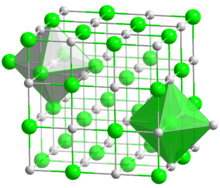Hafnium carbide

| |
| Identifiers | |
|---|---|
3D model (JSmol)
|
|
| ChemSpider | |
| ECHA InfoCard | 100.031.910 |
| EC Number |
|
PubChem CID
|
|
CompTox Dashboard (EPA)
|
|
| |
| |
| Properties | |
| HfC | |
| Molar mass | 190.50 g/mol |
| Appearance | black odorless powder |
| Density | 12.2 g/cm3[1] |
| Melting point | 3,958 °C (7,156 °F; 4,231 K)[2] |
| insoluble | |
| Structure | |
| Cubic crystal system, cF8 | |
| Fm3m, No. 225 | |
| Hazards | |
| GHS labelling: | |

| |
| Warning | |
| H228 | |
| NFPA 704 (fire diamond) | |
Except where otherwise noted, data are given for materials in their standard state (at 25 °C [77 °F], 100 kPa).
| |
Hafnium carbide (HfC) is a chemical compound of hafnium and carbon. Previously the material was estimated to have a melting point of about 3,900 °C.[2] More recent tests have been able to conclusively prove that the substance has an even higher melting point of 3,958 °C exceeding those of tantalum carbide and tantalum hafnium carbide which were both previously estimated to be higher.[3] However, it has a low oxidation resistance, with the oxidation starting at temperatures as low as 430 °C.[4] Experimental testing in 2018 confirmed the higher melting point yielding a result of 3,982 (±30°C) with a small possibility that the melting point may even exceed 4,000°C.[5]
Atomistic simulations conducted in 2015 predicted that a similar compound, hafnium carbonitride (HfCN), could have a melting point exceeding even that of hafnium carbide.[6] Experimental evidence gathered in 2020 confirmed that it did indeed have a higher melting point exceeding 4,000 °C,[7] with more recent ab initio molecular dynamics calculations predicting the HfC0.75N0.22 phase to have a melting point as high as 4,110 ± 62 °C, highest known for any material.[8]
Hafnium carbide is usually carbon deficient and therefore its composition is often expressed as HfCx (x = 0.5 to 1.0). It has a cubic (rock-salt) crystal structure at any value of x.[9]
Hafnium carbide powder is obtained by the reduction of hafnium(IV) oxide with carbon at 1,800 to 2,000 °C. A long processing time is required to remove all oxygen. Alternatively, high-purity HfC coatings can be obtained by chemical vapor deposition from a gas mixture of methane, hydrogen, and vaporized hafnium(IV) chloride.
Because of the technical complexity and high cost of the synthesis, HfC has a very limited use, despite its favorable properties such as high hardness (greater than 9 Mohs[10]) and melting point.[2]
The magnetic properties of HfCx change from paramagnetic for x ≤ 0.8 to diamagnetic at larger x. An inverse behavior (dia-paramagnetic transition with increasing x) is observed for TaCx, despite its having the same crystal structure as HfCx.[11]
See also
[edit]References
[edit]- ^ Physical Constants of Inorganic Compounds in Lide, D. R., ed. (2005). CRC Handbook of Chemistry and Physics (86th ed.). Boca Raton (FL): CRC Press. pp. 4–44 ff. ISBN 0-8493-0486-5.
- ^ a b c Harry Julius Emeléus (1968). "Metal Carbides". Advances in Inorganic Chemistry and Radiochemistry. Academic Press. pp. 169–170. ISBN 978-0-12-023611-4.
- ^ Cedillos-Barraza, Omar; Manara, Dario; Boboridis, K.; Watkins, Tyson; Grasso, Salvatore; Jayaseelan, Daniel D.; Konings, Rudy J. M.; Reece, Michael J.; Lee, William E. (2016). "Investigating the highest melting temperature materials: A laser melting study of the TaC-HFC system". Scientific Reports. 6: 37962. Bibcode:2016NatSR...637962C. doi:10.1038/srep37962. PMC 5131352. PMID 27905481.
- ^ Shimada, Shiro (October 1992). "Oxidation Kinetics of Hafnium Carbide in the Temperature Range of 480° to 600°C". Journal of the American Ceramic Society. 75 (10): 2671–2678. doi:10.1111/j.1151-2916.1992.tb05487.x.
- ^ Ushakov, Sergey V.; Navrotsky, Alexandra; Hong, Qi-Jun; van de Walle, Axel (26 August 2019). "Carbides and Nitrides of Zirconium and Hafnium". Materials. 12 (17): 2728. Bibcode:2019Mate...12.2728U. doi:10.3390/ma12172728. PMC 6747801. PMID 31454900.
- ^ Hong, Qi-Jun; van de Walle, Axel (2015). "Prediction of the material with highest known melting point from ab initio molecular dynamics calculations". Physical Review B. 92 (2): 020104. Bibcode:2015PhRvB..92b0104H. doi:10.1103/PhysRevB.92.020104. ISSN 1098-0121.
- ^ "Scientists Create World's Most Heat Resistant Material with Potential Use for Spaceplanes". Forbes.
- ^ Dai, Yu; Zeng, Fanhao; Liu, Honghao; Gao, Yafang; Yang, Qiaobin; Chen, Meiyan; Huang, Rui; Gu, Yi (15 October 2023). "Controlled nitrogen content synthesis of hafnium carbonitride powders by carbonizing hafnium nitride for enhanced ablation properties". Ceramics International. 49 (20): 33265–33274. doi:10.1016/j.ceramint.2023.08.035. eISSN 1873-3956. ISSN 0272-8842. OCLC 9997899259. S2CID 260672783.
- ^ Lavrentyev, A.A.; Gabrelian, B.V.; Vorzhev, V.B.; Nikiforov, I.Ya.; Khyzhun, O.Yu.; Rehr, J.J. (26 August 2008). "Electronic structure of cubic HfxTa1–xCy carbides from X-ray spectroscopy studies and cluster self-consistent calculations". Journal of Alloys and Compounds. 462 (1–2): 4–10. doi:10.1016/j.jallcom.2007.08.018.
- ^ James F. Shackelford; William Alexander, eds. (2001). CRC Materials Science and Engineering Handbook (3rd ed.). CRC Press. ISBN 978-0-849-32696-7.
- ^ Aleksandr Ivanovich Gusev; Andreĭ Andreevich Rempel; Andreas J. Magerl (2001). Disorder and Order in Strongly Nonstoichiometric Compounds: Transition Metal Carbides, Nitrides, and Oxides. Springer. pp. 513–516. ISBN 978-3-540-41817-7.

